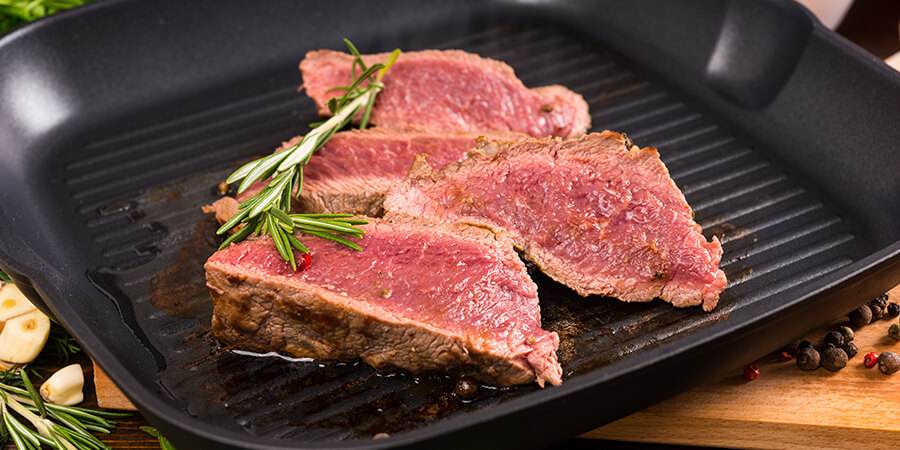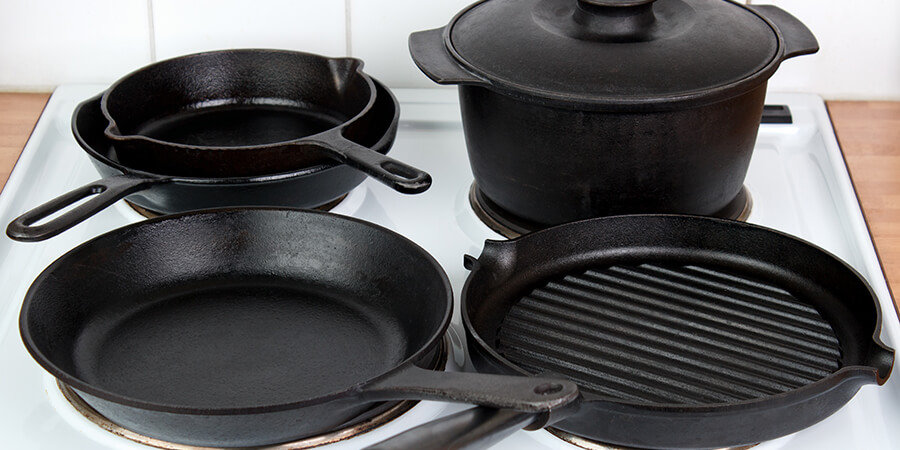7 Reasons You Need Cast Iron Cookware In Your Kitchen

Why use a cast iron skillet? Working in a commercial kitchen or as an experienced home cook, you may have heard the myth that cast iron doesn’t belong in the kitchen. However, this misconception is outdated and simply wrong. Cast iron is a durable, versatile choice that offers great performance in busy commercial kitchens.
Cast iron offers a natural nonstick surface that’s ideal for many different kinds of foods. It’s simply an invaluable tool for searing, frying, baking, serving, and more. You can enjoy many benefits of cast iron, such as easy cleaning, durable performance, steady heat transfer, and more. Explore 7 reasons why you need cast iron cookware in your working kitchen.

Benefits Of Cast Iron
1. Durable Materials
Cast iron frying pans and other cookware are long-term investments in your kitchen. Iron is a strong, durable material that holds up to heavy commercial use. These implements are cast as a single, solid piece, so they don’t have a structural weak point. There are many uses for cast iron, which can move from the range to the oven and beyond. Cast iron can even nestle directly among the flames of a wood-fired stove, making it the first choice of chefs everywhere.
2. Improves With Use
Unlike many materials, cast iron gets better as it ages. Cast iron pans and other commercial cookware becomes seasoned with regular use. In this process, the pan builds up a microscopic layer of fat from the previous food it’s cooked. An aged, well-maintained cast iron pot adds a special touch to any dish. Why use a cast iron skillet? Your food keeps getting better when you cook it in cast iron.
3. Can Be Cleaned With Soap
Contrary to popular belief, cast iron can be cleaned using standard methods. In the past, you risked losing a cast iron pan’s wonderful seasoning if you cleaned it using harsh soap. Line chefs and dishwashers couldn’t risk ruining a cast iron pot, but they also struggled to clean it using other methods. However, cast iron can be safely cleaned with soap. This is great news for keeping a clean kitchen while still using the finest tools.
4. Can Still Be Used If It Is Rusty
A little rust can be part of iron’s normal aging process. Luckily, there’s no need to toss cast iron pots due to rusty patches. One of the benefits of cast iron is that it remains useful after it becomes rusty. TableCraft brand and other top-quality cast iron implements can still be cooked in if they are rusty. The solid iron construction maintains its durability even with rusty surface patches.
5. Inexpensive Compared To Other Cookware
Cast iron is very reasonably priced compared to other types of cookware. The solid construction uses a simple, economical process. Molten iron is poured into a cast, or mold, in the shape of the intended pot or pan. This traditional fabrication method keeps costs low. You can add multiple cast iron pots, pans, griddles, and other tools to your kitchen while sticking to a budget.
6. Holds Heat Well
Cast iron holds and transfers heat remarkably well, making it one of the main types of pans you need in your kitchen. If you’ve ever asked what are cast iron skillets good for, the answer is almost everything. Thanks to their heat-retaining properties, cast iron tools can be used for many diverse cooking techniques. Keep a cast iron pan over a full-heat burner to sear meats, or turn down a cast iron pot to keep stock at a gentle but constant simmer. These implements are versatile choices for grilling, sautéing, blackening, and more.
7. Visually Appealing For Serving Food
Unlike most of your cookware, cast iron is at home in the front of the house as well as in the kitchen. Cast iron skillets and frying pans are classic serving options that offer a retro, rustic appeal at any table. Breakfast scrambles, fajitas, personal pizzas, cobblers, pies, and many other foods look delicious when served in a cast iron implement.
Maintaining Cast Iron Skillets

When properly cared for, cast iron is an investment that can last decades or even centuries. Many commercial kitchens may be wary of cleaning cast iron because they don’t want to risk losing the seasoning, or the thin layer of fat that develops on the surfaces of the iron. However, there are simple ways to keep any cast iron implement clean.
1. Clean It Immediately
Cast iron is easiest to clean when it’s still warm. Unlike other types of pot, don’t be tempted to let cast iron soak to loosen up any stuck-on food. Left behind food bits may loosen in the water, but you also risk rusting the pot.
2. Use Hot Water
Wash cast iron using the hottest water you can manage. Consider using gloves, tongs, or commercial sprayers if the water is too hot for you. A stiff scrubbing brush is an easy choice for cleaning cast iron.
3. Scrub To Remove Food Particles
Scrub your pot in running water to remove any stuck-on food. If you’re struggling with stubborn patches, make a paste of coarse kosher salt and water. Simply use this paste to scrub any hard-to-remove food.
4. Use Soap Sparingly
You can use soap on cast iron, but a little goes a long way. Aim to use the smallest amount of soap necessary to clean your pots.
5. Boil Water For Long-Lasting Food Residue
When salt paste and soap don’t remove leftover food, escalate to boiling water in the pan. The combination of heat and water should help loosen any food that won’t budge.
6. Dry Your Skillet
Keep your skillet rust-free by carefully drying it with a towel. You can also set empty cast iron pans on the stove over low heat to dry them.
7. Regularly Oil Your Cast Iron
You can enhance your cast iron’s seasoning by regularly oiling your pots and pans. Apply a thin layer of vegetable shortening or oil with a towel to your cast iron’s cooking surfaces after drying them. It’s especially important to oil cast iron to restore its surface after cleaning it with soap.
Explore Cast Iron Cookware

GoFoodservice offers everything you need for your commercial kitchen, including a wide range of industry-leading cast iron cookware.
Share This!